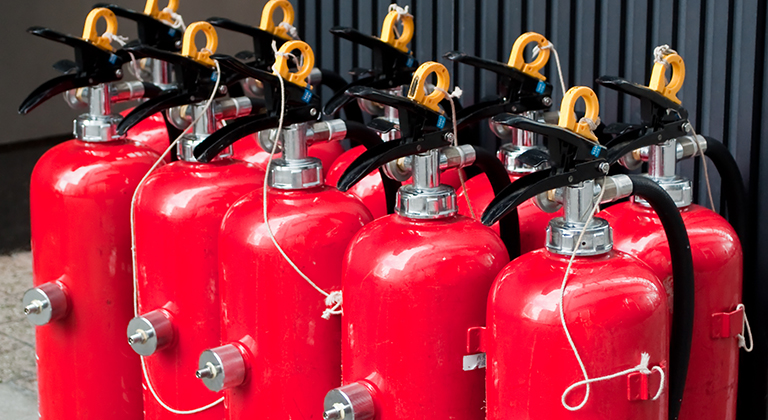Fire extinguisher safety
Controlling and fighting workplace fires
Even though you take the proper precautions, there is still the risk of fire in your workplace. But it’s a hazard you can help control.
Remember, all fires start as small fires that might be handled with portable fire extinguishers. The key is making sure you and your employees are prepared by:
Selecting the type of fire extinguishers for the kind of fire you expect
Distributing the proper number of extinguishers throughout the building for quick access
Training personnel to use the extinguishers
Installing extinguishers so they’re easily accessible and clearly marked
Maintaining all fire equipment
Types of fires
Controlling a fire means having the right kind of extinguisher on hand to handle it. There are a number of classifications of fires all dependent on the type of material burning:
Class A – Ordinary combustible materials, such as wood, cloth, paper, rubber, and many plastics
Class B – Flammable liquids like chemicals, greases, gasoline, and oils
Class C – Electrical equipment
Class D – Combustible metals like magnesium, titanium, zirconium, sodium, and potassium
Class K – Combustible cooking products like vegetable or animal oils and fats
Learn more about types of fires, and the appropriate extinguishers to use, along with details on proper use and servicing in our fire extinguisher downloadable document.
Types of fire extinguishers
Each of those classes of fires has a particular kind of fire extinguisher that’s designed to handle it. Here are some things to consider when selecting the type of extinguisher for your business:
Water
Antifreeze
Pump tank (water)
Dry chemical
Multi-purpose dry chemical
Carbon dioxide
Halon 1211
Halon 1301
Dry powder special compound
We have more details on fire extinguisher guidelines, including use and servicing in our fire extinguisher downloadable document.
Where to place them
How many fire extinguishers you need to protect your property depends on the area, the arrangement of your building, the severity of the hazard, classes of fires you’d expect, and the distance a person must travel to reach a fire extinguisher.
Fire extinguishers should be provided for the protection of both the building structure, if combustible, and the occupancy hazards.
Training employees
Even though it’s pretty clear how fire extinguishers work from their design, employees should be instructed and drilled in their use. That way they’ll be able to confidently use them in an emergency. Be sure to document this training.
Regulatory requirements
The National Fire Protection Association (NFPA) has set up standards to follow when it comes to the installation and use of fire extinguishers. Portable fire extinguishers are covered under NFPA 10 which addresses:
Monthly inspection: This is a quick check that an extinguisher is available, charged, and will operate. This is done by seeing that it is in its designated place, that it’s not been actuated or tampered with, and that there’s no obvious or physical damage that’ll prevent operation.
Annual maintenance: The extinguisher gets a thorough check to give maximum assurance that it’ll operate effectively and safely. It includes any necessary repair or replacement. Any maintenance, servicing, or recharging must be done by trained persons with the appropriate manuals.
Recharging: This is the replacement of the extinguishing agent and also includes the expellant for certain types of extinguishers.
Internal maintenance: The extinguisher is emptied, visually inspected, and recharged.
Hydrostatic test: This is a pressure test of the extinguisher cylinder or container to make sure it meets manufacturer standards. Extinguishers should be hydrostatically tested if, at any time, they show evidence of corrosion or mechanical problems, and depending on type, every five or twelve years. We have more details on fire extinguisher guidelines, including use and servicing in our fire extinguisher downloadable document.
Replacing old extinguishers
If you already have extinguishers in place at your business, be sure to check that they meet current standards.
Since 1971, inverting type fire extinguishers have not been manufactured in the United States because of poor performance. Those include:
Soda-acid
Foam
Water cartridge
Loaded steam cartridge
When last made, all of these discontinued types were two-and-a-half-gallon capacity, although some were produced in one-and-a-half- and five-gallon sizes with various metals and fabricating methods. Millions of these obsolete extinguishers still remain in service.
Because these inverting extinguishers aren’t under constant pressure, they’re not defined as pressure vessels and can’t meet pressure vessel codes. For example, a soda-acid extinguisher is required to be rated at 900 PSI. In practice, most soda-acid inverted units were rated only at 350 PSI. Since it’s not unusual for them to generate internal pressures of 300 PSI when they’re operated, they are being stressed very close to their breaking point. That’s led to a number of deadly accidents caused by an exploding extinguisher. In fact, hydrostatic testing finds a 22-percent average failure rate in inverted extinguishers.
The other type of extinguisher to replace if it’s in your business are Halon extinguishers. Since 1995, these units are no longer produced and existing ones can’t be recharged. Halon was discontinued after it was found to contribute to atmosphere ozone depletion.
When replacing extinguishers, look for those listed by Underwriters Laboratories, Inc. (UL) for best performance.
Remember, a good fire extinguisher safety program may help save lives and might even save you money in your fire insurance premium. A Sentry Safety specialist can explain other benefits and additional ways to help protect your business.
Related resources
Avoiding falls in the workplace
We’ve put together some simple safety rules you can use in your workplace that could help cut down on the risk of dangerous falls.
Silent danger in the workplace
It’s colorless, odorless, and a danger for some workers. But there are things you can do to help keep carbon monoxide from becoming deadly. We have some tips.






